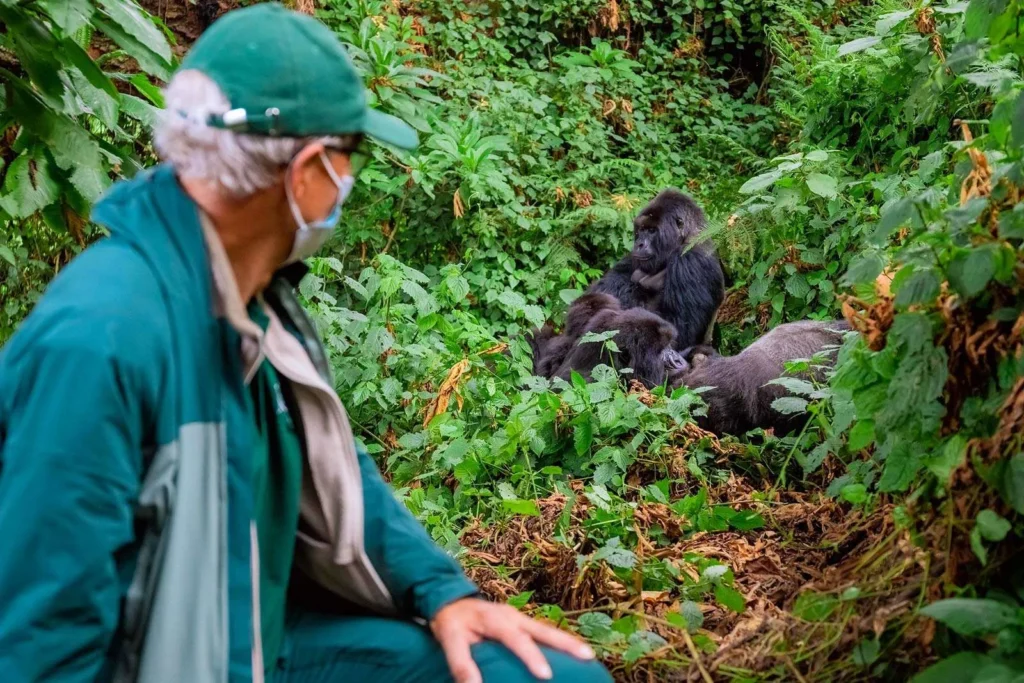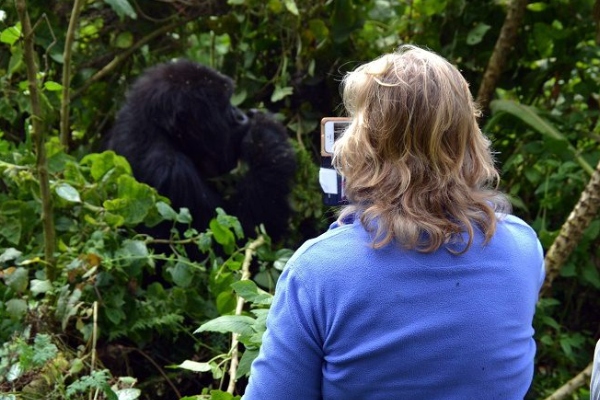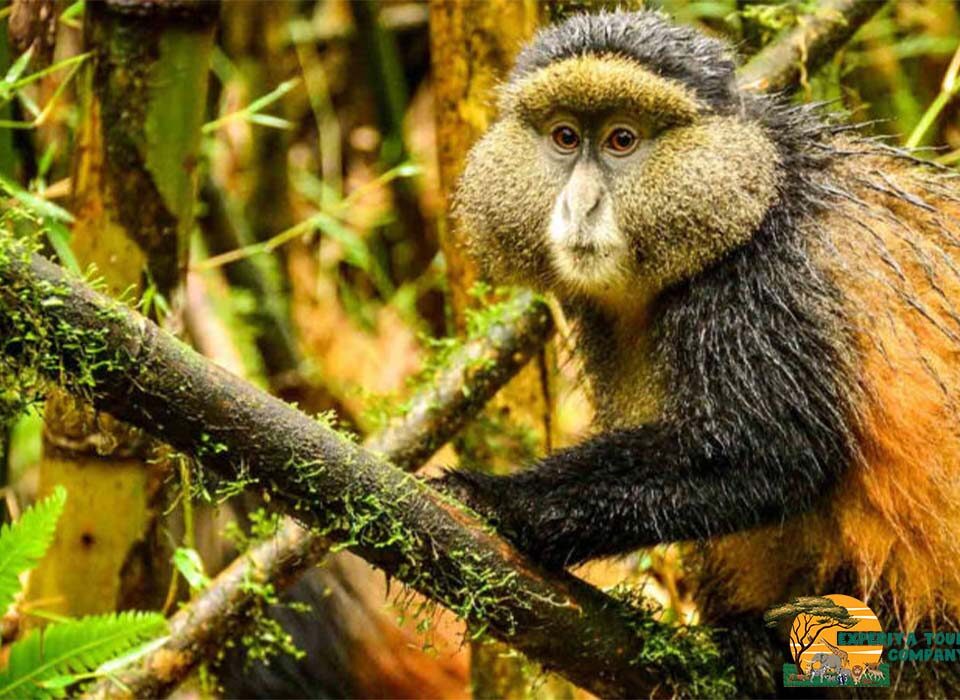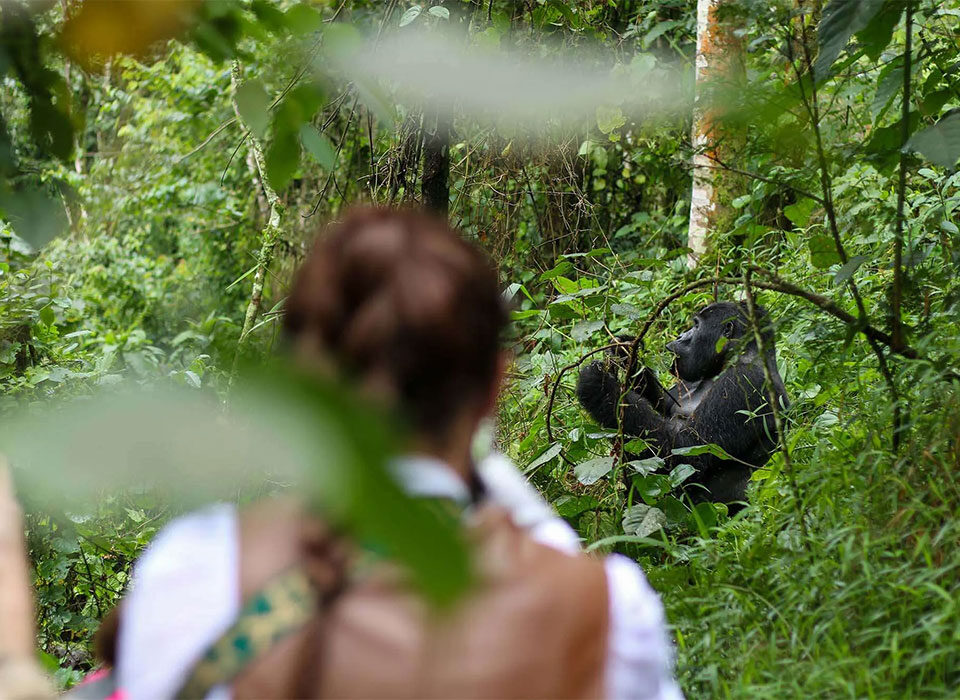
What’s the best time to visit Bwindi Impenetrable National Park?
October 22, 2025
What should I pack for gorilla trekking in Uganda?
October 22, 2025How Difficult Is Gorilla Trekking in Bwindi?
Gorilla trekking in Uganda’s Bwindi Impenetrable National Park is one of the most remarkable wildlife experiences on earth. It’s a journey that takes you deep into a prehistoric forest, through tangled vines and mist-shrouded hills, in search of the endangered mountain gorilla — a creature that shares over 98% of our DNA. But while the rewards are extraordinary, many travelers often ask the same question before they book: “How difficult is gorilla trekking in Bwindi?”
The honest answer is — it can be challenging, but entirely manageable with the right mindset, preparation, and guidance. The experience isn’t about physical toughness alone; it’s a combination of endurance, patience, and respect for nature. Whether you’re a seasoned hiker or a first-time adventurer, understanding the terrain, conditions, and pacing can make all the difference in turning a tough trek into a life-changing encounter.
Understanding Bwindi Impenetrable National Park
Bwindi Impenetrable National Park lies in southwestern Uganda, near the borders of Rwanda and the Democratic Republic of Congo. Covering about 331 square kilometers, this ancient rainforest is one of Africa’s most biologically diverse ecosystems and a UNESCO World Heritage Site.
The park’s name — “Impenetrable” — perfectly describes its terrain. It’s a rugged landscape of steep hills, slippery trails, dense vegetation, and humid air. Elevations range between 1,160 meters and 2,607 meters above sea level, meaning trekkers can expect some serious climbs and descents during their hike.
Bwindi is divided into four main gorilla trekking sectors: Buhoma (North), Ruhija (East), Rushaga (South), and Nkuringo (Southwest). Each offers a unique environment and varying levels of trekking difficulty, largely determined by the gorilla group’s location on any given day.
How Challenging Is Gorilla Trekking in Bwindi?
The difficulty of gorilla trekking depends on several factors — terrain, altitude, weather, and individual fitness levels. While some visitors find the trek relatively easy, others consider it strenuous. However, almost everyone agrees that the moment you find yourself standing a few meters from a silverback gorilla, every step, slip, and sweat drop becomes worth it.
1. Terrain and Trails
Bwindi’s trails are steep, narrow, and often covered with thick undergrowth. Some sections require you to push through bushes, balance on muddy slopes, or cross streams on slippery logs. Because gorillas live deep within the forest, the trek may involve climbing hills and descending valleys repeatedly until the trackers locate them.
Trails aren’t fixed; they are created fresh each morning by park rangers who follow gorilla tracks. This means no two treks are ever the same. Some groups may be found within 30 minutes of hiking, while others may take 2 to 6 hours to reach. In rare cases, a trek can extend beyond 7 hours, depending on how far the gorillas have moved overnight.
2. Altitude and Elevation Changes
Bwindi’s high altitude adds another layer of difficulty. At elevations above 1,600 meters, the air becomes thinner, and some trekkers may notice mild breathlessness, especially during uphill climbs. However, the hikes are conducted at a slow, steady pace, with frequent stops to rest, drink water, and admire the forest’s beauty.
3. Weather and Ground Conditions
Bwindi’s rainforest receives rainfall throughout the year. Even during the dry seasons (June–September and December–February), unexpected showers can occur. Rain transforms the ground into a slippery mix of mud and leaves, making trekking more demanding. Good hiking boots with strong grip are essential.
The forest also remains humid and misty, meaning you’ll sweat even when temperatures feel cool. Dressing in breathable, quick-dry clothing helps maintain comfort during the trek.
4. Length and Duration of the Trek
The duration of a gorilla trek varies widely. Some families are located near the park’s boundary, requiring only an hour or two of hiking. Others live deeper within the forest, requiring longer treks. On average, most visitors spend 3 to 5 hours trekking (round trip), including time spent observing the gorillas.
Once you find the gorilla family, you’ll spend a full hour watching and photographing them as they feed, groom, and interact. That hour often feels like a dream — a peaceful, intimate moment that makes the strenuous journey fade from memory.
5. Physical Fitness
While you don’t need to be an athlete, a moderate level of physical fitness is helpful. Being able to walk uphill for several hours without exhaustion will make the experience more enjoyable. Light exercises like walking, jogging, or stair climbing for a few weeks before your trip can make a big difference.
However, even elderly travelers and those with mild mobility challenges have successfully completed gorilla treks. Porters and rangers provide incredible support, ensuring everyone has a fair chance to meet the gorillas.

The Role of Porters and Walking Sticks
One of the best decisions any trekker can make is hiring a local porter. For around USD 20–30, a porter will carry your backpack, help you up steep sections, and offer a steady hand during slippery descents. This isn’t just about convenience — it’s also a direct way to support the surrounding communities that depend on gorilla tourism.
Additionally, every trekker receives a walking stick at the briefing point. This simple tool becomes invaluable for balance and stability on uneven terrain. Many trekkers say it’s what saved them from slipping countless times during the hike.
Sector-by-Sector Trekking Difficulty
Each of Bwindi’s four sectors offers a slightly different trekking experience:
Buhoma Sector (North): The original and most accessible sector. Treks here are moderate, and some families stay close to the park entrance. Ideal for older travelers or those seeking a less demanding hike.
Ruhija Sector (East): Known for its scenic views but higher altitude. Treks can be more challenging, but the cool air and panoramic landscapes make it worthwhile.
Rushaga Sector (South): Home to the highest number of habituated families. Terrain varies from easy to moderately difficult. It’s also where the Gorilla Habituation Experience takes place — a longer, more immersive trek.
Nkuringo Sector (Southwest): The most physically demanding area, with steep slopes and longer distances. However, it rewards trekkers with incredible views of the Virunga Volcanoes and a sense of raw adventure.
Your tour operator (like Experiya Tour Company) can help you choose the sector best suited to your fitness level and expectations.
How Rangers Make Trekking Easier
Every gorilla trek in Bwindi is led by highly trained Uganda Wildlife Authority rangers and trackers. Early in the morning, a team of trackers heads into the forest to locate the gorillas using fresh nests, droppings, and broken vegetation. Once they confirm a group’s position, they communicate with the guides via radio, allowing trekkers to head directly in that direction.
During the trek, rangers set a comfortable pace, stopping often to rest and share information about the forest, plants, birds, and primates. Their expertise not only enhances your experience but also ensures your safety — especially in areas with wild elephants or buffalo.
Mental Preparation: The Hidden Challenge
While the physical challenge is real, the mental aspect of gorilla trekking is just as important. The forest’s unpredictability — the length of the trek, the humidity, and the constant climb and descent — can test your patience. The key is to embrace it as part of the adventure.
When you finally meet the gorillas, every hardship disappears. Watching a mother cradle her infant or a giant silverback peacefully chewing bamboo reminds you why this experience is unlike any other on the planet.
Tips to Make Your Trek Easier
- Train in advance: Start walking or hiking at least a few weeks before your safari.
- Hire a porter: They’re incredibly helpful and worth every dollar.
- Wear the right gear: Waterproof boots, gloves, and a rain jacket are essentials.
- Stay hydrated: Bring plenty of water and light snacks like energy bars.
- Take your time: It’s not a race. The rangers set the pace for everyone’s comfort.
- Use trekking poles: They can reduce strain on your knees during steep climbs.
- Keep a positive attitude: The trek is part of the adventure — enjoy every moment.
Who Can Go Gorilla Trekking?
Anyone aged 15 years and above can take part in gorilla trekking in Bwindi. People of all ages and fitness levels have completed treks successfully, including seniors in their seventies. Rangers tailor the pace to accommodate all trekkers, and special arrangements (like sedan chairs) can be made for those with mobility limitations.
Ultimately, determination matters more than strength. If you can walk steadily for a few hours and have a spirit of adventure, you’re fully capable of conquering Bwindi’s trails.
The Reward After the Challenge
When you finally reach your assigned gorilla family, exhaustion melts away. The air feels still, yet charged with energy. The gorillas carry on as if you’re invisible — feeding, grooming, or watching you curiously from a few meters away. That quiet hour in their company transcends words. You realize that the trek’s difficulty wasn’t an obstacle — it was part of what made the encounter meaningful.
Every breath, every climb, and every muddy step adds to the anticipation that culminates in one of life’s greatest privileges: looking into the eyes of a wild mountain gorilla.
Trek with Experiya Tour Company
If you’re ready to take on the adventure of gorilla trekking in Bwindi, choosing the right safari operator is key. Experiya Tour Company is one of Uganda’s most trusted and experienced operators, specializing in gorilla trekking and wildlife safaris across East Africa.
Experiya’s expert guides understand the terrain, the gorilla families, and the rhythm of the forest. They handle every detail — from securing permits to choosing the best sector for your fitness level and arranging comfortable lodges near the park. Their personalized itineraries ensure that your trek is not just successful but deeply memorable.
Whether you’re looking for a luxury experience, a photographic safari, or a once-in-a-lifetime wildlife expedition, Experiya Tour Company will make it effortless and extraordinary. With their care, expertise, and commitment to conservation, your journey to Bwindi becomes more than a trek — it becomes a story you’ll tell forever.




